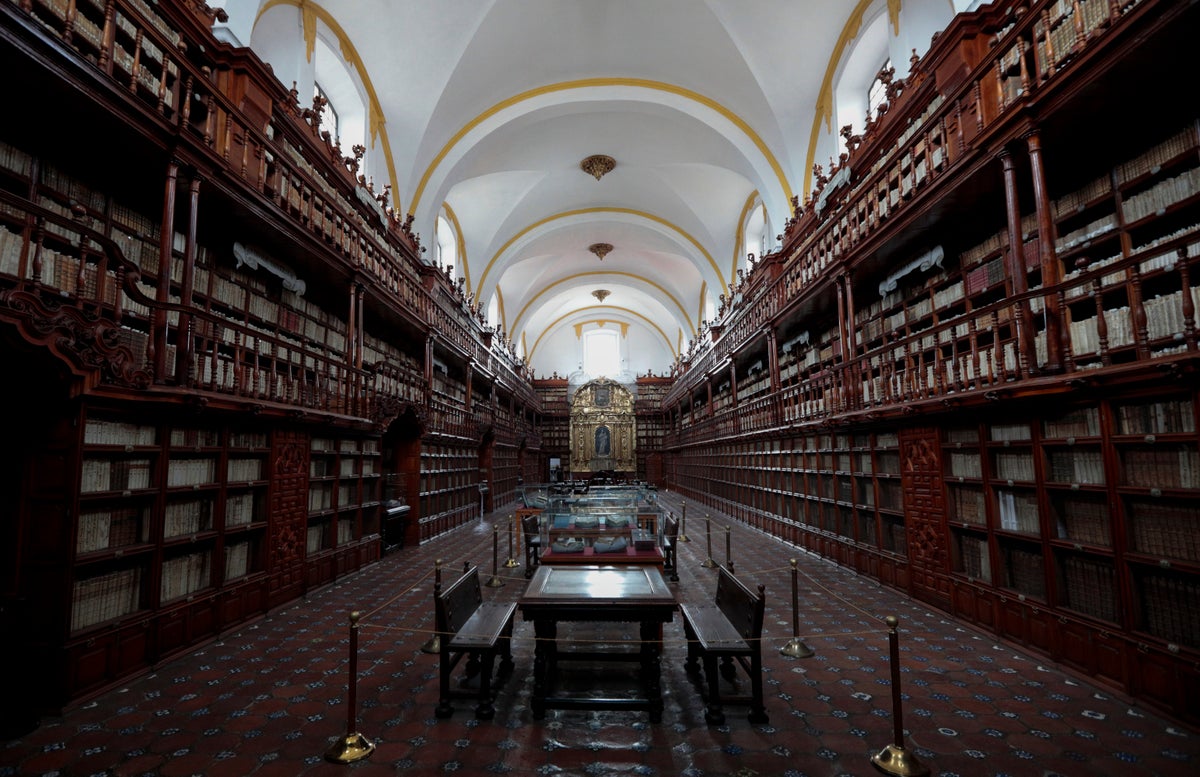
It is, according to UNESCO, the oldest public library in the Americas, tucked away from the street front at a cultural center in the historic heart of this Mexican city. Those who enter the Palafoxiana Library for the first time — seeing the high, vaulted ceiling and gold-framed painting of the Virgin Mary — might think they’ve arrived at a chapel.
Indeed, the library owes its existence to one of Puebla’s early Catholic bishops, Juan de Palafox y Mendoza, who in 1646 donated his private library of 5,000 volumes to a local religious college — with the hope that anyone who knew how to read would have access to them.
In 1773, more than a century after Palafox’s death, the bishop of that era ordered the construction of a majestic library to house the collection. The walls were fitted with two tiers of wooden bookshelves; a third tier was added in the 19th century as donations flowed in from religious leaders and laypeople. There are now more than 45,000 volumes and manuscripts.
The books are organized according to principles of scholastic philosophy which held that the foundation of all knowledge is God and reason is subordinate to faith.
On the first floor, there are more than 11,000 Bibles, religious documents and theological texts. The second level is dedicated to the relationship between God and people — chronicles of religious orders and the lives of saints — and the third contains books on physics, mathematics, botany, language, architecture, even carpentry.
In effect, the overall collection navigates between two worlds — the word of God coexisting with the contributions of humankind.
“Everything that was imagined at that time is in the library,” said Juan Fernández del Campo, the library’s current manager.
Among the library’s greatest treasures are nine incunabula — books made between 1450 and 1500 with Gutenberg’s first printing techniques — and volumes by Galen and Vesalius, who are renowned for their contributions to the study of medicine.
Inside the library there are no explanatory texts that reveal the enigmas of the Palafoxiana to its visitors, but at the entrance there are always volunteer guides who recount its history to whoever is interested. Fernández del Campo said access to the materials is often prioritized for researchers who show a clear justification for their request.
Palafox’s passion for books is evident in a quote from him, written on a mosaic outside the library.
“He who finds himself without books finds himself in solitude without consolation,” it says.
Yet Fernández del Campo, from an office hidden behind the altar of the Virgin out of the eye of tourists, said those words from the bishop should interpreted within the context of his time.
“If you read what Palafox said and look back in the history of Mexico, you say: Wait a minute, no. This was not the time for Mexico to raise its wings toward freedom of thought,” the library manager said.
Indeed, the historical record suggests Palafox sought to assert the authority of Spain’s king and the Catholic Church hierarchy, putting him at odds with religious orders such as the Jesuits who questioned the royal authority.
Amid that friction, Palafox was transferred to Spain in 1653. The Jesuits were expelled from the Spanish Empire a century later; many of their books were added to the Palafox collection when the order abandoned Puebla.
According to the World Monuments Fund, the added weight of the books stored on the library’s third tier made the bookshelves more susceptible to damage when earthquakes struck Puebla in 1999.
Following the quakes, the fund participated in an extensive restoration project. Cracks in the walls and vaults were repaired and the bookcases were restructured.
The library reopened in 2002; two years later it was added by UNESCO to its Memory of the World Register.
___
IF YOU GO: Puebla is about 80 miles (130 kilometers) by highway from Mexico City, easily reached by car or bus. In recent years the library has been open every day but Monday, with free admission on Sundays and Tuesdays and a modest entrance fee the other days.







